Leonardo Bundle
Who Buys from Leonardo Company?
Understanding the customer base is vital for any business, and for a global powerhouse like Leonardo Company, it's absolutely critical. From its roots in post-war Italy to its current status as a leader in aerospace, defense, and security, Leonardo's success hinges on knowing its audience. This exploration dives deep into the Leonardo SWOT Analysis, revealing the intricacies of their customer demographics and target market.
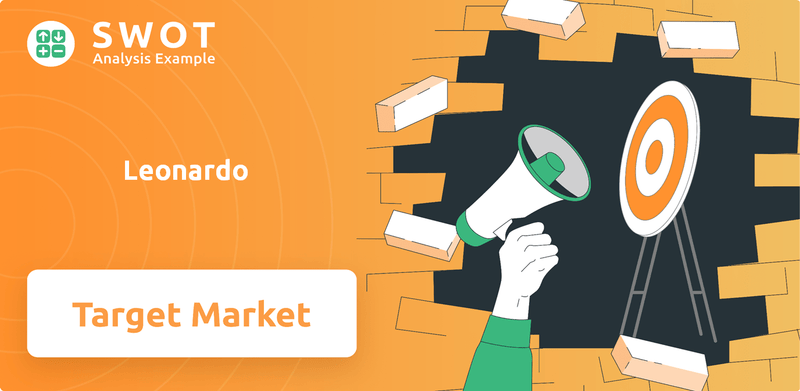
This deep dive into Leonardo Company's customer profile analysis will explore the company's customer segmentation strategies and provide a comprehensive market analysis. We'll uncover the characteristics of Leonardo Company's target audience, examining their needs, wants, and how Leonardo strategically positions itself to capture market share and drive growth. Ultimately, this analysis aims to define Leonardo Company's target market, providing insights into customer acquisition strategies and the company's overall consumer behavior analysis.
Who Are Leonardo’s Main Customers?
Understanding the primary customer segments is crucial for analyzing the business profile of the Leonardo Company. The company operates mainly in the Business-to-Government (B2G) and Business-to-Business (B2B) sectors. This focus shapes its target market and influences its strategic decisions. A detailed market analysis reveals the key demographics and characteristics of its clientele.
The core customer base of Leonardo consists of governments, armed forces, and other defense and security institutions globally. These entities drive the company's revenue streams, with defense systems, helicopters, and aeronautical equipment being the primary contributors. The customer segmentation reflects a strategic alignment with the evolving needs of the defense and security sectors.
In 2024, Leonardo's revenue was significantly influenced by defense systems, helicopters, and aeronautical equipment. The company's order backlog reached approximately €44 billion in 2024, indicating strong demand from its core segments. The Italian government, as the largest shareholder with a 30.2% stake, exemplifies the governmental focus of the company.
The customer demographics of Leonardo are primarily national defense ministries, governmental agencies, and large corporations involved in defense and security. These entities make up the target market for Leonardo's products and services. The company's focus on these segments is evident in its contracts and strategic initiatives.
The target market characteristics include a demand for advanced defense systems, helicopters, and aeronautical equipment. The company's strategic plan anticipates further strengthening of its core business in Defence and Security Electronics and Helicopters in 2025. The company's U.S. subsidiary, Leonardo DRS, recorded $3.2 billion in revenue for the full year 2024.
Leonardo segments its market based on the type of customer, such as governments and defense institutions. Its product offerings are tailored to meet the specific needs of these segments. The company's participation in major international defense projects, like the Eurofighter and NH-90, further illustrates its segmentation strategy.
Leonardo positions itself as a provider of advanced defense and security solutions. The company's strategic focus is on strengthening its core business. The company's market share and growth are influenced by its ability to meet the evolving needs of its target market.
The primary customer segments for Leonardo are governments, armed forces, and defense and security institutions. These segments drive the company's revenue and shape its strategic direction. Understanding these segments is critical for analyzing the company's market positioning and growth potential.
- Governments: National defense ministries and governmental agencies.
- Armed Forces: Military organizations worldwide.
- Defense and Security Institutions: Entities focused on security and defense.
- Large Corporations: Companies involved in defense and security.
Leonardo SWOT Analysis
- Complete SWOT Breakdown
- Fully Customizable
- Editable in Excel & Word
- Professional Formatting
- Investor-Ready Format
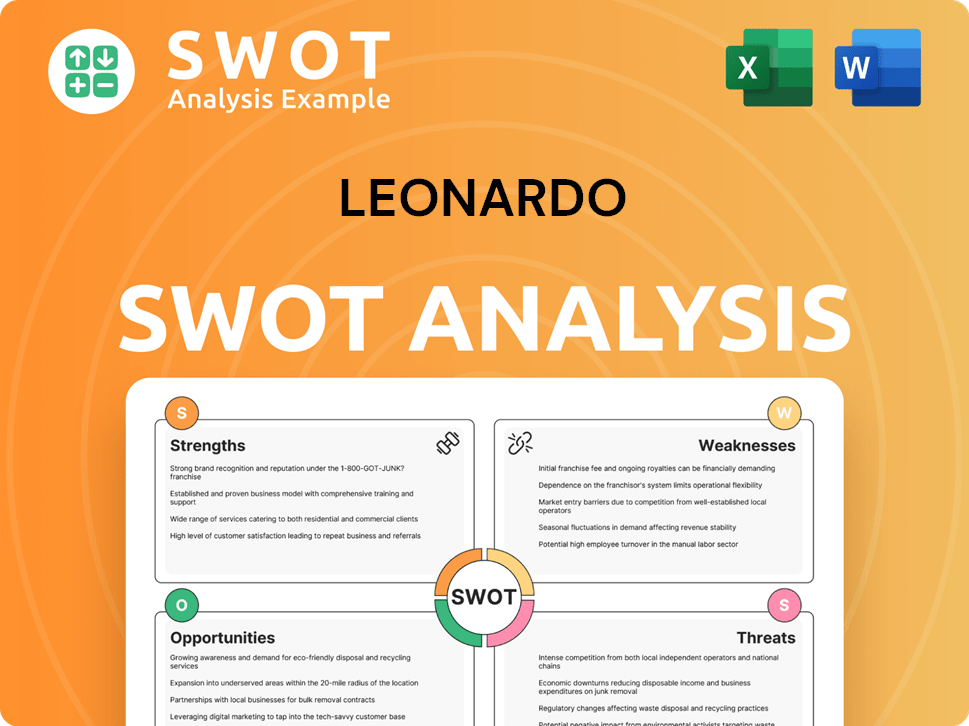
What Do Leonardo’s Customers Want?
Understanding the customer needs and preferences is crucial for the success of any company, and for the Owners & Shareholders of Leonardo, this is especially true. The company's primary customers are governments and defense agencies, who have specific requirements that drive their purchasing decisions. This focus shapes the company's product development, service offerings, and overall market strategy, helping it maintain a competitive edge in the defense industry.
The defense industry is driven by complex needs, and the Leonardo Company addresses these through its diverse portfolio. This includes helicopters, aircraft, and cybersecurity solutions. The company's ability to meet these needs is a key factor in its success. This involves understanding the specific demands of its customers and tailoring its offerings to meet those needs effectively.
The Leonardo Company focuses on providing cutting-edge solutions to its customers. This includes investing in advanced technologies and forming strategic alliances to enhance its product offerings. By understanding the customer's needs and preferences, the company can develop products and services that meet those needs effectively, ensuring its continued success in the defense market.
The Leonardo Company's customers, primarily governments and defense agencies, prioritize advanced technological capabilities, reliability, security, and long-term support. Their purchasing behaviors are driven by national security requirements and the need for cutting-edge solutions. The company's focus on these areas is reflected in its product development and service offerings.
- Advanced Technological Capabilities: Customers seek state-of-the-art solutions.
- Reliability and Security: Products must meet stringent standards.
- Long-Term Support: Customers require comprehensive training and after-sales support.
- Multi-Domain Systems: Demand for integrated solutions, including drones and AI-driven analytics.
- Cost-Effectiveness: Customers evaluate the total cost of ownership over the product's lifespan.
Leonardo PESTLE Analysis
- Covers All 6 PESTLE Categories
- No Research Needed – Save Hours of Work
- Built by Experts, Trusted by Consultants
- Instant Download, Ready to Use
- 100% Editable, Fully Customizable
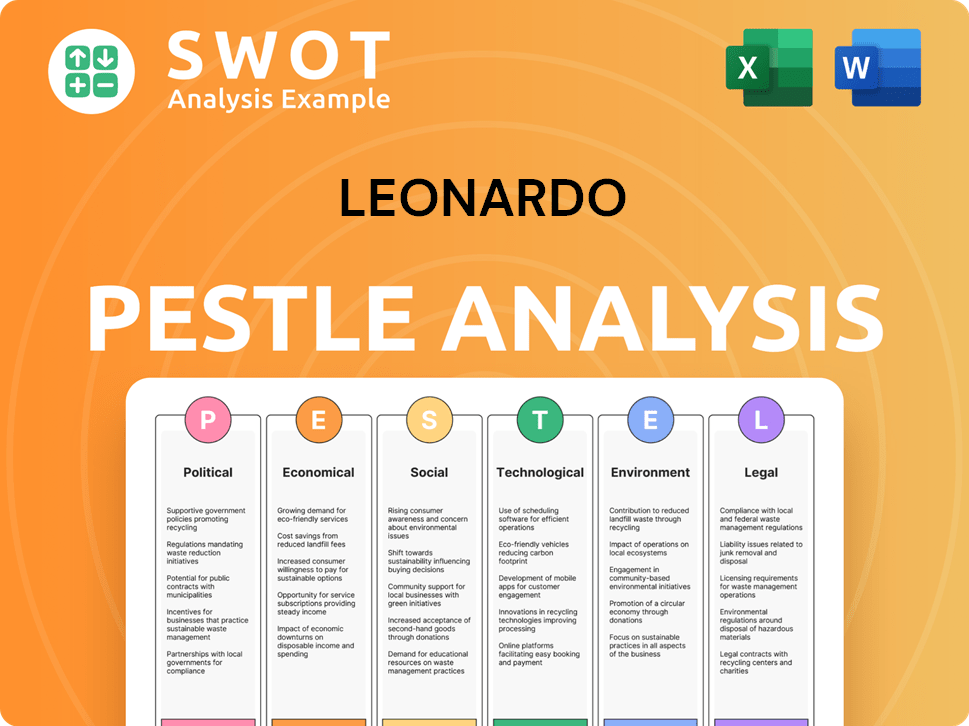
Where does Leonardo operate?
The geographical market presence of the company is extensive, with significant operations and commercial activities spread across the globe. Production facilities and key commercial bases are strategically located in Italy, the United Kingdom, Poland, and the United States. This widespread presence allows the company to serve a diverse customer base and capitalize on market opportunities worldwide.
The company's products, systems, and services are utilized in approximately 150 countries. This broad international reach underscores the company's commitment to global markets and its ability to meet the needs of customers in various regions. The company's success is demonstrated by its ability to adapt its offerings and strategies to different markets.
In 2024, the distribution of net sales highlights the company's strong presence in key markets. The United States is the largest defense market for the company, significantly contributing to its revenue. The company's strategic investments and partnerships further solidify its position in crucial regions, ensuring long-term growth and market leadership.
In 2024, Italy accounted for 18.2% of net sales, the United Kingdom for 12.3%, Europe (excluding Italy and the UK) for 26.4%, and the United States for 23.2%. The remaining 19.9% came from other regions, showcasing a diversified revenue stream.
Strategic partnerships are key to the company's market approach. The joint venture with Rheinmetall to produce main battle tanks and the Lynx platform for the Italian government has potential contracts worth up to €27 billion. This venture also opens up international sales opportunities.
The company is actively expanding its market presence through acquisitions and partnerships. The acquisition of Precision Aviation Services (now Leonardo South Africa) demonstrates a commitment to Sub-Saharan Africa. A 25.1% stake in Hensoldt enhances its presence in the European defense market.
The company adapts its offerings and partnerships to succeed in diverse markets. For example, the company has increased its in-country maintenance capacity in Brazil by over 50% with a new helicopter service and logistics center. This localization strategy supports its global growth.
The United States is the largest defense market. The company's strategic investments and partnerships are key to its global strategy. The company's global footprint is a result of its strong presence in key markets and its ability to adapt to local market needs.
- The company's products are used in approximately 150 countries.
- The company's net sales distribution shows a strong presence in Europe and the United States.
- The company is expanding through strategic partnerships and acquisitions.
- The company is adapting to local market needs.
Leonardo Business Model Canvas
- Complete 9-Block Business Model Canvas
- Effortlessly Communicate Your Business Strategy
- Investor-Ready BMC Format
- 100% Editable and Customizable
- Clear and Structured Layout
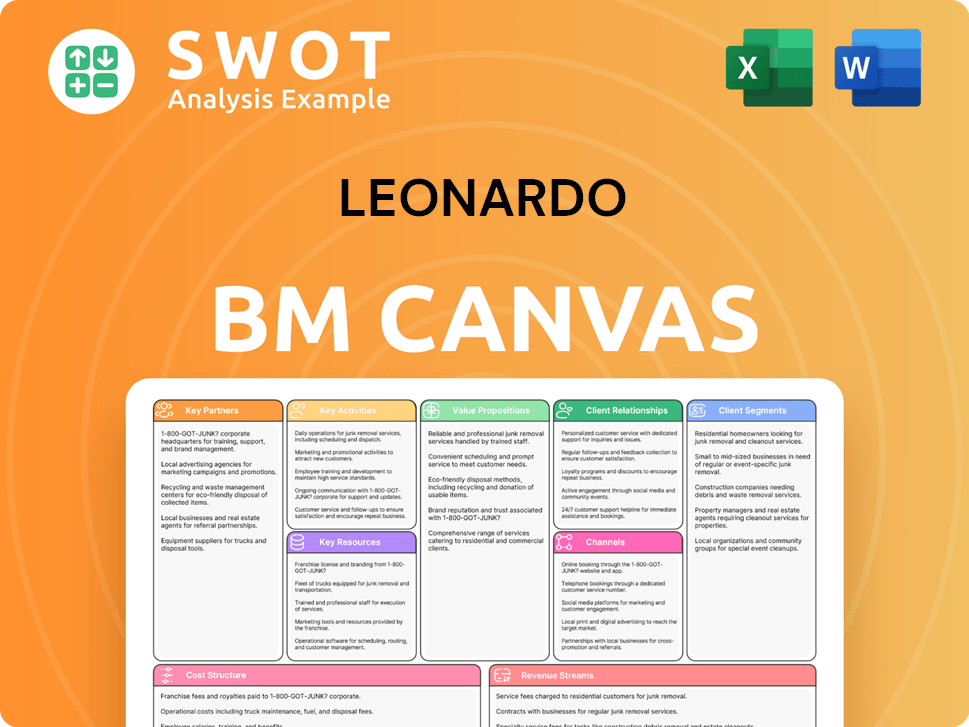
How Does Leonardo Win & Keep Customers?
The customer acquisition and retention strategies of the Leonardo Company are centered around long-term relationships with governmental bodies and defense organizations. These strategies emphasize technological leadership, comprehensive support, and strategic partnerships. The company's robust order backlog, which reached €44.2 billion in 2024, indicates successful acquisition efforts and ensures revenue visibility for the coming years. In Q1 2025, new orders totaled €6.9 billion, marking a 20.6% increase, with a book-to-bill ratio of 1.2x.
Leonardo's approach to customer acquisition is multifaceted, involving direct engagement with government defense ministries, participation in international defense programs, and strategic alliances. The company's involvement in major international programs like Eurofighter, NH-90, FREMM, and the Global Combat Air Programme (GCAP) is a testament to its proactive acquisition strategy. The recent agreement to establish a joint venture for GCAP, equally owned by Leonardo, BAE Systems, and Japan Aircraft Industrial Enhancement Co Ltd (JAIEC), exemplifies this strategy, aiming to develop a sixth-generation combat aircraft by 2035.
Retention strategies are crucial for Leonardo, focusing on extensive after-sales support, maintenance, and training services, which are vital for the long operational lifecycles of its products. Leonardo’s global network, supporting more than 4,500 helicopters for over 1,500 customers across 150 countries, highlights the company's commitment to customer service. Furthermore, Leonardo is investing in digital customer care, including AI bots for 24/7 support to improve service and operational efficiency. These strategies are essential for maintaining and growing its customer base in the defense sector. To understand more about the company's financial structure, consider exploring the Revenue Streams & Business Model of Leonardo.
Leonardo actively engages with government defense ministries to secure contracts and build relationships. This direct approach is fundamental to understanding and meeting the specific needs of governmental clients. The company's success in securing significant orders, as reflected in its order backlog, is a direct result of these efforts.
Involvement in international defense programs such as Eurofighter and GCAP allows Leonardo to collaborate with other leading defense companies and access global markets. These programs provide opportunities for large-scale contracts and technological advancements, contributing to the company's growth and global presence.
Strategic alliances are key to expanding Leonardo's capabilities and market reach. The joint venture for GCAP exemplifies this, bringing together expertise from different companies to develop advanced defense technologies. Such partnerships enable Leonardo to share risks, pool resources, and offer comprehensive solutions to customers.
Leonardo provides extensive after-sales support, maintenance, and training services to ensure the long operational lifecycles of its products. This includes a global network of service centers and digital customer care solutions. These services are essential for maintaining customer satisfaction and loyalty, leading to repeat business.
Leonardo focuses on technological leadership to offer cutting-edge solutions. This includes investments in research and development, particularly in areas like AI and digital customer care. The company's ability to innovate and provide advanced products and services is a key differentiator in the market.
Comprehensive support, including training and maintenance, ensures that customers can fully utilize and maintain their products. This commitment to support builds strong relationships and enhances customer satisfaction. The company's global network of service centers is a critical component of this strategy.
Incorporating customer feedback into product development ensures that Leonardo's offerings align with evolving needs. This customer-centric approach helps the company to continuously improve its products and services, maintaining its competitive edge. The company consistently ranks high in customer satisfaction surveys.
Investing in digital customer care, such as AI bots for 24/7 support, improves service efficiency and customer experience. This enhances accessibility and provides quick solutions to customer issues. It also allows Leonardo to gather data and insights to improve its services further.
Leonardo's commitment to continuous improvement in customer service is reflected in its top rankings in external surveys. This dedication to excellence ensures that the company remains competitive and maintains strong relationships with its customers. It also fosters a culture of innovation and responsiveness.
Building long-term relationships with governmental bodies and defense organizations is central to Leonardo's customer acquisition and retention strategy. This focus on sustained partnerships ensures repeat business and provides a stable revenue stream. These relationships are built on trust, reliability, and mutual benefit.
Leonardo Porter's Five Forces Analysis
- Covers All 5 Competitive Forces in Detail
- Structured for Consultants, Students, and Founders
- 100% Editable in Microsoft Word & Excel
- Instant Digital Download – Use Immediately
- Compatible with Mac & PC – Fully Unlocked
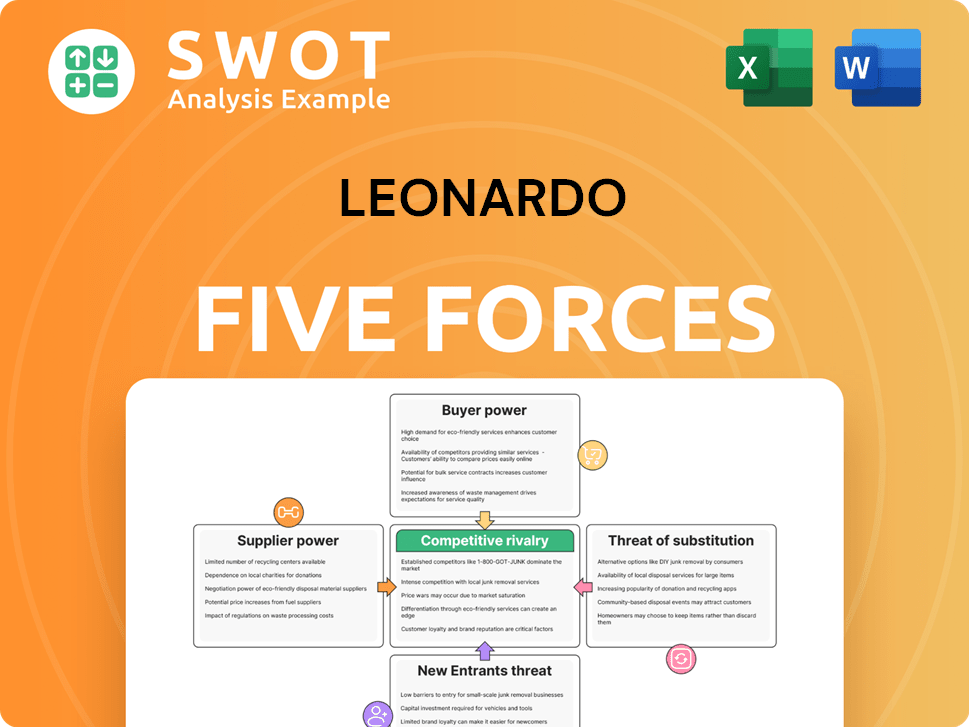
Related Blogs
- What are Mission Vision & Core Values of Leonardo Company?
- What is Competitive Landscape of Leonardo Company?
- What is Growth Strategy and Future Prospects of Leonardo Company?
- How Does Leonardo Company Work?
- What is Sales and Marketing Strategy of Leonardo Company?
- What is Brief History of Leonardo Company?
- Who Owns Leonardo Company?
Disclaimer
All information, articles, and product details provided on this website are for general informational and educational purposes only. We do not claim any ownership over, nor do we intend to infringe upon, any trademarks, copyrights, logos, brand names, or other intellectual property mentioned or depicted on this site. Such intellectual property remains the property of its respective owners, and any references here are made solely for identification or informational purposes, without implying any affiliation, endorsement, or partnership.
We make no representations or warranties, express or implied, regarding the accuracy, completeness, or suitability of any content or products presented. Nothing on this website should be construed as legal, tax, investment, financial, medical, or other professional advice. In addition, no part of this site—including articles or product references—constitutes a solicitation, recommendation, endorsement, advertisement, or offer to buy or sell any securities, franchises, or other financial instruments, particularly in jurisdictions where such activity would be unlawful.
All content is of a general nature and may not address the specific circumstances of any individual or entity. It is not a substitute for professional advice or services. Any actions you take based on the information provided here are strictly at your own risk. You accept full responsibility for any decisions or outcomes arising from your use of this website and agree to release us from any liability in connection with your use of, or reliance upon, the content or products found herein.